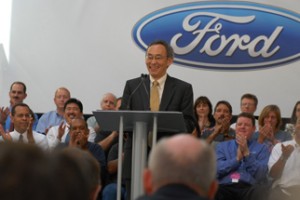
"By supporting key technologies and sound business plans, we can jump start the production of fuel efficient vehicles in America."
One year after the program was announced by the Bush administration in 2007, the first three auto loans for developing advanced technology were granted to the Ford Motor Company, Nissan Motors and Tesla Motors.
The $8 billion in conditional loan commitments for the development of advanced vehicle technologies include $5.9 billion for Ford Motor Company to “transform factories” across Illinois, Kentucky, Michigan, Missouri, and Ohio to produce 13 more fuel efficient models; $1.6 billion to Nissan North America, Inc. to retool its Smyrna, Tennessee factory to build advanced electric automobiles and to build an advanced battery manufacturing facility; and $465 million to Tesla Motors to manufacture electric drivetrains and electric vehicles in California.
These are the first loan commitments disbursed as part of the Department of Energy’s Advanced Technology Vehicles Manufacturing program, dubbed section 136, which has $25 billion in U.S. taxpayer funding. The Department plans to make additional loans over the next several months to large and small auto manufacturers and parts suppliers up and down the production chain.
Chrysler and General Motors are, for the moment, excluded because of their financial fragility, and, we surmise, their extremely unpopular taxpayer loans or potential giveaways that they have already received.
“We have an historic opportunity to help ensure that the next generation of fuel-efficient cars and trucks are made in America,” said President Obama. “These loans – and the additional support we will provide through the Section 136 program — will create good jobs and help the auto industry to meet and even exceed the tough fuel economy standards we’ve set, while helping us to regain our competitive edge in the world market.”
“By supporting key technologies and sound business plans, we can jump start the production of fuel efficient vehicles in America,” Energy Secretary Steven Chu said. “These investments will come back to our country many times over – by creating new jobs, reducing our dependence on oil, and reducing our greenhouse gas emissions.”
These commitments — it is claimed — will help reduce the 140 billion gallons of gasoline Americans consume annually, lessening the nation’s dependence on oil. President Carter had announced a similar energy independence programs more than three decades ago, but it was subverted by special interests that included oil and domestic car companies. And the Obama administration is now struggling with climate change and energy policy bills in Congress, as special interest pick them apart.
The Obama Administration recently announced an agreement to raise passenger car fuel standards from 27.5 miles per gallon to a target of 35 miles per gallon (mpg) by 2016. Trucks face a much smaller increase. MPG goals beyond that are supposed to be set at a higher limit using maximum feasible technologies.
The current fuel economy program when combined with increasing stringent emission requirements will likely add $1,500 to $3,000 a new car or more, at a time when American consumers are facing the greatest decline in personal wealth in decades, as unemployment continues to rise unabated and the global economy continues to contract at levels not seen since the Great Depression and World War II.
The Advanced Technology Vehicles Manufacturing Loan Program is said to be “an open and competitive process focusing on the best companies and best technologies in American manufacturing.” It is supposed to promote multiple approaches for achieving a fuel-efficient economy, which critics maintain is the least efficient way to spend taxpayer dollars, since it duplicate efforts among makers,which is already clearly evident, and pays for product development that the marketplace would have forced anyway.
One of the more controversial grants pending involves Coda Battery Systems, which wants U.S. taxpayer funds for Chinese electric car imports, but ultimately using U.S. built batteries. Coda says it will import to California by the fall of 2010 a four-door, five-passenger electric sedan built it manufacturing partner, Hefei, a state-owned Chinese defense manufacturer of automobiles and airplanes.
At first, the sedan will be sold with a battery system from a joint venture between Coda Automotive and Chinese-based Tianjin Lishen Battery Company, a large supplier of lithium-ion batteries. If the U.S. plant appears, batteries from it would be substituted to power the Chinese car. Even here U.S. taxpayer subsidies would go the Chinese, since Coda intends to make Lishen part of the U.S. manufacturing joint venture.
